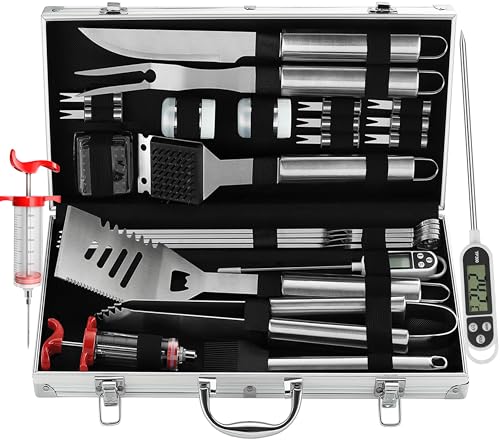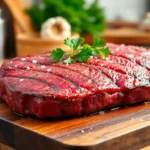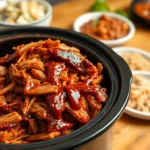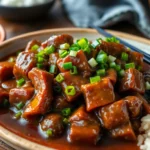BBQ foil packets transform your grilling game with minimal prep and maximum flavor. We love how these versatile bundles lock in moisture and create perfectly steamed vegetables while infusing everything with smoky goodness. There’s something magical about unwrapping these silver parcels to reveal tender, juicy ingredients that’ve been cooking in their own delicious juices.
These grill packets aren’t just convenient – they’re genius. We’ve discovered they’re perfect for feeding crowds without the hassle of juggling multiple dishes on the grill. From classic potato and veggie combinations to protein-packed meals with chicken or sausage, the possibilities are endless.
What makes foil packet grilling so appealing is the cleanup factor. We’re talking about complete meals that cook themselves while you enjoy time with family and friends. No flipping required, no worry about food falling through the grates, and absolutely no messy cleanup afterward.
What Are BBQ Foil Packets for the Grill
BBQ foil packets are sealed pouches made from aluminum foil that contain a complete meal of proteins, vegetables, and seasonings. We create these versatile cooking vessels by placing ingredients on a sheet of heavy-duty foil and folding the edges to form an airtight seal. The sealed environment traps steam and moisture while the food cooks directly on the grill grates.
These packets function as individual ovens that cook food through a combination of steam and direct heat transfer. We can customize each packet with different ingredients, seasonings, and cooking times to accommodate various dietary preferences and taste profiles. The foil barrier protects delicate ingredients from direct flame while allowing the smoky grill flavors to penetrate through the sealed edges.
The cooking method relies on the principle of steam cooking combined with radiant heat from the grill. Food releases natural juices that create steam within the sealed packet, resulting in tender, moist results. We achieve optimal cooking by placing packets directly on medium-high heat zones of our grill for even temperature distribution.
BBQ foil packets accommodate a wide range of ingredients from lean proteins like chicken breast and fish fillets to heartier options such as sausages and beef strips. Vegetables maintain their nutrients and vibrant colors when cooked in this enclosed environment. Root vegetables, bell peppers, zucchini, and onions work particularly well in foil packet combinations.
The sealed cooking environment intensifies flavors by concentrating natural juices and seasonings. Herbs, spices, and marinades penetrate ingredients more effectively when trapped within the foil barrier. We can add butter, olive oil, or wine to enhance moisture content and create flavorful cooking liquids that baste the ingredients throughout the cooking process.
Essential Equipment and Tools

Having the right equipment transforms our BBQ foil packet grilling experience from challenging to effortless. We need exact tools to create secure packets and handle them safely on the grill while maintaining optimal cooking conditions.
Heavy-Duty Aluminum Foil
Heavy-duty aluminum foil forms the foundation of successful packet grilling. We recommend choosing heavy-duty foil over standard thickness because it provides superior durability during the grilling process. This sturdy material creates airtight seals that trap moisture and prevent tears when we flip or move packets on the grill grates.
Grill Handling Tools
Proper grill tools ensure safe and efficient packet management throughout the cooking process. We rely on grill tongs with scalloped edges to securely grip foil packets without puncturing the aluminum. Heat-resistant grill gloves or mitts protect our hands when placing packets directly onto hot grill surfaces or removing them after cooking.
Grill spatulas and forks help us maneuver packets and check doneness by carefully opening sealed edges. We always keep grill brushes on hand to clean grill grates before cooking, ensuring our foil packets won’t stick to debris or residue.
Temperature Monitoring Equipment
Digital or probe thermometers eliminate guesswork when cooking proteins inside sealed foil packets. We insert these tools through small openings in the foil to verify that meats reach safe internal temperatures without fully unwrapping the packets.
| Tool Type | Purpose | Key Feature |
|---|---|---|
| Heavy-duty foil | Packet creation | Superior tear resistance |
| Scalloped tongs | Safe handling | Secure grip without punctures |
| Heat-resistant gloves | Hand protection | Safe packet placement |
| Digital thermometer | Temperature check | Accurate internal readings |
Additional Useful Accessories
Butcher twine secures foil packets tightly when folding alone doesn’t create adequate seals. We use this technique for packets containing liquid marinades or loose ingredients that might leak during cooking.
Half-size cooling racks or grate accessories elevate foil packets above direct grill contact. This elevation promotes even heat circulation and prevents packets from sticking to grill surfaces while cooking.
Smoke tubes or boxes add smoky flavors to our foil packet meals without requiring wood chips directly on the grill. Grill covers and presses provide enhanced heat control and prevent flare-ups that could damage our carefully sealed packets.
Custom grill tool sets often include all essential items like tongs, spatulas, forks, and brushes in coordinated collections. These complete sets support every step of our foil packet grilling process from preparation through cleanup.
Ingredients

Creating perfect BBQ foil packets requires selecting quality ingredients that cook at similar rates and complement each other. We’ve organized our ingredient recommendations into three essential categories to help you build flavorful and satisfying meals.
Protein Options
Chicken serves as our top protein choice for BBQ foil packets. Chicken thighs and drumsticks work exceptionally well because they remain moist during the cooking process and absorb BBQ sauce flavors beautifully. We season the chicken pieces thoroughly before coating them with your preferred BBQ sauce.
Fish offers a lighter alternative that cooks quickly in foil packets. Salmon fillets and white fish varieties like cod or tilapia pair wonderfully with vegetables and maintain their delicate texture when steamed.
Beef and pork provide heartier options for those seeking robust flavors. Cut these proteins into uniform pieces to ensure even cooking throughout the packet.
Vegetable Selections
Potatoes form the foundation of most foil packets because they absorb surrounding flavors while providing satisfying substance. We recommend cutting potatoes into small cubes and combining them with sliced onions for optimal cooking results.
Mixed vegetables add color and nutrition to your packets. Frozen mixed vegetables work perfectly and eliminate prep time, while fresh bell peppers, carrots, and corn bring vibrant flavors and textures.
Additional vegetables like zucchini, mushrooms, and broccoli expand your options. These vegetables cook quickly and retain their nutritional value when steamed in sealed foil packets.
Seasoning and Sauce Options
BBQ sauce serves as the star flavoring agent for your packets. Honey BBQ sauce and Buffalo Wild Wings Honey BBQ Sauce create rich, tangy coatings that penetrate the protein during cooking. We apply sauce both before sealing the packet and after cooking for maximum flavor impact.
Dry spices enhance the natural flavors of your ingredients. Salt, garlic powder, and smoked paprika form our essential seasoning blend that complements both proteins and vegetables.
Olive oil prevents sticking and promotes even cooking. We drizzle olive oil over vegetables and potatoes to improve texture and help seasonings adhere properly during the grilling process.
Prep Instructions

Proper preparation forms the foundation of successful BBQ foil packet grilling. We’ll walk through each essential step to ensure your packets cook evenly and deliver maximum flavor.
Preparing the Foil
We start with heavy-duty aluminum foil to prevent tearing during the cooking process. Cut sheets large enough to accommodate all your ingredients with extra space for proper sealing. Lay each piece of foil on a flat surface and prepare your workspace for efficient assembly.
The key to effective foil packets lies in creating an airtight seal that traps steam inside. We bring the foil edges together at the top and crimp them tightly to prevent any moisture from escaping. This sealed environment ensures juicy meats and perfectly cooked vegetables every time.
Cutting and Seasoning Ingredients
Uniform cutting ensures even cooking throughout your foil packets. We cube chicken breast into bite-sized pieces and dice potatoes to similar dimensions. Vegetables like onions and peppers should be chopped consistently to match the cooking time of your proteins.
Season your meats and vegetables generously with salt and pepper as your base. We enhance flavor profiles with garlic powder and smoked paprika for depth. Red pepper flakes add heat when desired. Mix proteins with BBQ sauce or honey-chipotle for moisture and enhanced taste. Drizzle vegetables with olive oil and season them to complement your chosen meat.
Assembly Techniques
Layer vegetables at the bottom of each foil sheet to promote proper heat circulation and flavor melding. Place your seasoned meat on top of the vegetables to allow natural juices to flow downward during cooking.
Fold the foil edges together tightly and roll or crimp to create a complete seal with no gaps for steam to escape. We avoid flipping packets during grilling since the steam cooking method works effectively from one side. Cooking time ranges from 15 to 25 minutes over medium-high heat depending on your ingredients.
| Ingredient Type | Cooking Time | Internal Temperature |
|---|---|---|
| Chicken and potatoes | 20 minutes | 165°F |
| Fish and vegetables | 15-18 minutes | 145°F |
| Beef and root vegetables | 22-25 minutes | 160°F |
Add cheese or additional sauces near the end of cooking by carefully opening the packet and resealing before returning to the grill briefly. This technique melts toppings perfectly without overcooking your main ingredients.
Grilling Directions

Now that we have our ingredients prepped and packets assembled, it’s time to fire up the grill and create perfectly cooked foil packet meals. Following proper grilling techniques ensures even cooking and maximum flavor development.
Setting Up Your Grill
We recommend heating our grill to medium or medium-high heat, targeting temperatures between 350°F to 400°F for optimal results. Gas grill users should place foil packets directly over the medium heat zone, while charcoal grill enthusiasts need to position packets 4 to 6 inches from medium coals.
Keeping the grill lid closed throughout the cooking process maintains consistent heat and creates the steam environment our packets need. We place packets seam-side up directly on the grill grates to prevent any potential leaking of juices or ingredients.
Cooking Times and Temperatures
Different ingredients require exact timing and temperature considerations for perfect results. We’ve compiled essential cooking guidelines to help achieve consistent outcomes:
| Ingredient Type | Temperature | Cooking Time | Notes |
|---|---|---|---|
| Vegetable Foil Packs | Medium heat | 25-35 minutes | Cook until tender |
| Potatoes | 400°F | 15-20 minutes | Pierce easily with fork when done |
| Ribs Wrapped in Foil | Direct medium heat | 1 hour | Turn occasionally |
| General Range | Medium to medium-high | 15-60 minutes | Varies by thickness and density |
Cooking times depend significantly on the thickness and density of our chosen ingredients. Dense vegetables like potatoes require longer cooking periods, while tender items like fish cook more quickly.
How to Check for Doneness
We carefully open one corner of the foil packet to avoid dangerous steam burns when checking for doneness. Testing vegetables and potatoes by piercing with a fork ensures they’ve reached the proper tender consistency we’re looking for.
Meat products like ribs require internal temperature verification to ensure food safety and optimal tenderness. We use a digital thermometer to confirm proteins have reached their safe internal temperatures without fully unwrapping the packets.
Undercooked ingredients simply need resealing and additional grilling time. We check progress every few minutes after resealing to prevent overcooking and maintain the ideal texture and flavor balance.
Popular BBQ Foil Packet Combinations

Building on our foundation techniques and ingredient selection, we explore the most beloved foil packet combinations that deliver exceptional results every time. These tried and tested combinations showcase how different proteins and vegetables work harmoniously together on the grill.
Chicken and Vegetable Packets
Chicken breast cubes seasoned with salt, pepper, garlic powder, smoked paprika, and red pepper flakes create the perfect protein base for this classic combination. We recommend mixing the seasoned chicken with BBQ sauce before assembly to ensure maximum flavor penetration during cooking.
Baby potatoes and chopped onions tossed with olive oil and seasonings form the vegetable foundation that should be layered beneath the chicken in the foil. This arrangement allows the natural chicken juices to flow down and enhance the vegetables while cooking.
Grilling over medium-high heat for approximately 20 minutes ensures the chicken reaches the safe internal temperature of 165°F while the potatoes become perfectly tender. Adding shredded cheddar cheese during the final minutes of cooking creates a rich, melted topping that elevates the entire dish.
Finishing touches include extra BBQ sauce and fresh green onions sprinkled over the completed packet for added flavor and visual appeal.
Beef and Potato Packets
Beef and potato combinations typically feature sliced or cubed cuts such as steak or ground beef paired with hearty vegetables. We prefer using tender cuts that respond well to the steam cooking method created within the sealed foil environment.
Seasoning the beef generously with your favorite spice blend before combining with potatoes and onions or bell peppers ensures every bite delivers robust flavor. The foil packet method prevents the beef from drying out while the steam from the potatoes helps tenderize the meat naturally.
Adding cheese or a splash of beef broth before sealing creates additional moisture and richness that complements the hearty nature of this combination. Cooking times vary based on the cut of beef used, but internal temperature should reach appropriate safety levels for the exact protein.
Seafood Foil Packets
Seafood foil packets excel with fish like salmon paired with lemony asparagus or shrimp combined with garlic butter and aromatic spices. High heat cooking sears the seafood while the trapped steam ensures even cooking throughout.
Shrimp foil packets recreate the beloved flavors of a traditional shrimp boil in a convenient, individualized format that eliminates mess and simplifies serving. The combination of shrimp with corn, potatoes, and seasonings delivers authentic coastal flavors.
Clam bake packets featuring fresh clams, sweet corn, potatoes, and compound butter replicate the traditional clam bake experience without requiring a pit oven or extensive cleanup. These packets seal in all the briny, buttery flavors that make seafood cooking so appealing.
The high heat method works particularly well for seafood as it prevents overcooking while maintaining the delicate textures that make these proteins special.
Vegetarian Options
Garden vegetable medleys including potatoes, mushrooms, onions, garlic, bell peppers, zucchini, and corn create satisfying vegetarian foil packets that work as either main dishes or substantial sides. These combinations benefit from generous seasoning and olive oil or butter to enhance natural flavors.
Plant-based proteins or cheese additions transform these vegetable packets into complete meals that satisfy even the heartiest appetites. The sealed foil environment ensures vegetables retain their vibrant colors and optimal nutrient content.
Tightly wrapping the seasoned vegetables and grilling until tender creates perfectly cooked results with minimal effort and maximum flavor retention. The steam created within the packet keeps vegetables moist while concentrating their natural flavors for exceptional taste.
Pro Tips for Perfect Foil Packets

Mastering these essential techniques will transform your foil packet grilling from good to exceptional. These proven methods ensure consistently delicious results every time we fire up the grill.
Sealing Techniques
Heavy-duty aluminum foil forms the foundation of successful packet grilling since it resists tears and maintains structural integrity throughout the cooking process. We arrange our ingredients in the center of a large foil piece then bring the longer edges together above the food. Folding these edges down tightly creates the initial seal while repeating this process with the shorter edges ensures a completely secure packet.
Crimping the edges well traps steam inside and creates the sealed environment that keeps food moist and flavorful during grilling. We always position our packets seam side up on the grill to maintain the seal and prevent precious juices from leaking out. One layer of heavy-duty foil typically provides adequate protection for standard grilling while two layers offer extra security when cooking directly in hot coals.
Preventing Burning
Indirect heat cooking prevents both foil burning and food scorching while maintaining optimal cooking temperatures. Gas grill users should heat one side and place packets on the burner that remains off or set to low heat. Charcoal grill enthusiasts can arrange coals on one side and position packets on the cooler side for gentle indirect cooking.
Adding liquid ingredients such as wine, broth, or oil inside each packet creates beneficial steam and prevents food from drying out. We preheat our grill to at least 400°F before placing foil packets to ensure proper heat distribution and cooking control. When cooking directly in contact with coals we use two layers of foil to shield food from excessive heat and potential scorching.
Even Cooking Methods
Arranging ingredients in a single layer inside the foil enables even cooking and allows thorough steam circulation throughout the packet. We avoid overcrowding ingredients since this prevents uniform heat distribution and can result in unevenly cooked food. Never flip foil packets during grilling because the trapped steam cooks food evenly from all sides without requiring any turning.
Cooking times vary significantly based on ingredients and thickness. Fish fillets typically require about 10 minutes while vegetables may need 15 minutes or more depending on their density and the grill temperature. We let packets rest briefly after removing them from the grill before opening to allow juices to settle and finish the gentle cooking process.
Make-Ahead Instructions

Preparing BBQ foil packets ahead of time transforms our grilling experience into a stress-free gathering with family and friends. We can assemble complete packets up to 24 hours before grilling and store them in the refrigerator for maximum convenience.
Pre-Assembly Storage Guidelines
Raw foil packets maintain optimal freshness when refrigerated for up to one day before cooking. We recommend labeling each packet with contents and intended recipient to streamline serving during busy grilling sessions. Double wrapping provides extra durability during storage and transport.
Pre-Cooking Method
We can fully precook foil packets in the oven at 400°F for 15-20 minutes before our grilling event. This technique works exceptionally well for camping trips or large gatherings where grill space becomes limited. After cooling properly we store precooked packets in the refrigerator for up to two days or freeze them for longer storage.
Reheating Instructions
Precooked packets require only 8-12 minutes on a preheated 450°F grill to warm through completely. We check internal temperatures reach 165°F for poultry and 145°F for seafood to ensure food safety. This method delivers the same delicious results with significantly reduced active cooking time.
Transportation Tips
Keeping packets chilled during transport maintains ingredient freshness and prevents bacterial growth. We use insulated coolers with ice packs and avoid leaving prepared packets at room temperature for more than two hours. Sealed packets travel exceptionally well for camping adventures or tailgating events.
Freezer Storage Options
Assembled raw packets freeze successfully for up to three months when properly wrapped and labeled. We thaw frozen packets completely in the refrigerator overnight before grilling. This approach allows us to batch prepare multiple meals during slower weekends for busy weeknight dinners.
Storage and Reheating

Proper storage of our BBQ foil packets ensures we can enjoy delicious grilled meals safely and conveniently. We recommend pre-chopping and measuring ingredients at home for maximum freshness. Store these prepped components separately in airtight containers or resealable bags to prevent contamination and maintain quality.
Storing Assembled Packets
Once we’ve assembled our foil packets, keeping them cool becomes crucial for food safety. Place completed packets in a cooler with plenty of ice packs or an insulated bag during transport. We should seal premade foil packets inside additional plastic bags or airtight containers to protect them from melted ice water or condensation in the cooler.
After cooking and cooling, store leftover foil packets in airtight containers or resealable bags in the refrigerator. Our cooked packets remain safe to eat for 3 to 4 days when properly refrigerated.
Reheating Guidelines
Reheating our BBQ foil packets offers versatility through multiple methods. We can reheat them over a grill, campfire, or in an oven depending on our preference and available equipment. Before reheating on a grill or campfire, carefully open the foil packets and add a small amount of butter, condiments, or a tablespoon of water to prevent the meal from drying out.
Wrapping packets with an additional layer of aluminum foil helps protect the food from tears and retains moisture during the reheating process. We maintain ideal grilling temperatures between 375-400°F, ensuring heat comes from hot coals or embers rather than open flames to prevent burning.
| Reheating Method | Temperature Range | Additional Tips |
|---|---|---|
| Grill/Campfire | 375-400°F | Use hot coals, not open flames |
| Oven | 375°F | Remove from foil if using microwave |
| Campfire (no grate) | Hot embers | Double or triple wrap packets |
Safety and Handling Tips
When working without a metal grate, double or triple wrap our packets and place them carefully on embers using fire-resistant gloves or tongs. For refrigerated leftovers, we can reheat in the oven or microwave without foil until the food reaches proper temperature throughout. Note that vegetables may become softer during the reheating process.
We always use oven mitts or tongs to handle hot foil packets safely. Allow packets to rest for a few minutes after reheating to let flavors meld together. Remember to practice responsible disposal by packing out all used foil and trash when camping or grilling outdoors.
These storage and reheating methods make our BBQ foil packet meals convenient for camping, cookouts, or meal prep while maintaining food safety and quality throughout the process.
Conclusion
BBQ foil packets transform your grilling experience into something truly special. We’ve covered everything from selecting the right ingredients to mastering proper sealing techniques that lock in incredible flavors.
The beauty of this cooking method lies in its simplicity and versatility. Whether you’re preparing a weeknight dinner or hosting a backyard gathering these packets deliver consistent results every time.
Now it’s time to fire up your grill and put these techniques into practice. Start with our recommended combinations and don’t be afraid to experiment with your own favorite ingredients. Your taste buds will thank you for discovering this game-changing approach to outdoor cooking.
Frequently Asked Questions
What are BBQ foil packets?
BBQ foil packets are sealed pouches made from aluminum foil containing complete meals with proteins, vegetables, and seasonings. They create an airtight environment that traps steam and moisture, cooking food through a combination of steam and direct heat. Each packet can be customized with different ingredients to suit various dietary preferences.
Why should I use BBQ foil packets for grilling?
BBQ foil packets enhance flavor and retain moisture in food while providing exceptional convenience. They eliminate the need to manage multiple dishes on the grill, prevent messes, and reduce cleanup time. The sealed cooking method intensifies flavors, preserves nutrients, and ensures tender, moist results every time.
What type of foil should I use for BBQ packets?
Heavy-duty aluminum foil is essential for BBQ foil packets due to its superior durability and tear resistance. Regular foil may puncture easily, compromising the airtight seal needed for proper cooking. Heavy-duty foil ensures your packets stay sealed throughout the grilling process, maintaining moisture and preventing leaks.
How long do BBQ foil packets take to cook?
Cooking times vary based on ingredients and thickness. Chicken typically takes 20-25 minutes, beef 15-20 minutes, fish 12-15 minutes, and vegetables 15-20 minutes. Use a digital thermometer to verify proteins reach safe internal temperatures: chicken (165°F), beef (145°F), and fish (145°F).
Can I prepare BBQ foil packets ahead of time?
Yes, you can prepare BBQ foil packets up to 24 hours in advance and store them in the refrigerator. Keep assembled packets cool during transport using a cooler with ice packs. For longer storage, you can freeze prepared packets for up to 3 months.
What are the best ingredients for BBQ foil packets?
Chicken thighs and drumsticks work best for proteins due to moisture retention. Potatoes serve as an excellent foundational vegetable, while mixed vegetables add color and nutrition. Essential seasonings include BBQ sauce, dry spices, and olive oil to enhance flavors and prevent sticking.
How do I prevent my foil packets from burning?
Use indirect heat cooking on medium to medium-high heat settings. Place packets away from direct flames and add liquid ingredients like broth or wine for steam. Arrange ingredients in a single layer for even cooking, and avoid overcrowding packets to ensure proper heat distribution.
How should I store leftover BBQ foil packets?
Refrigerate leftover packets for 3-4 days in airtight containers. For reheating, use the grill, oven (350°F for 10-15 minutes), or campfire. Add a splash of liquid if contents appear dry. Always ensure reheated food reaches safe internal temperatures before serving.
What grilling tools do I need for foil packets?
Essential tools include scalloped tongs for safe handling, heat-resistant gloves, and a digital thermometer for checking doneness. Additional helpful accessories include butcher twine for securing packets, cooling racks for resting, and custom grill tool sets for enhanced convenience and safety.
Can I make vegetarian BBQ foil packets?
Absolutely! Create satisfying vegetarian packets using combinations of potatoes, bell peppers, zucchini, mushrooms, and onions. Season with olive oil, herbs, and spices. Add cheese toward the end of cooking for extra flavor. Vegetarian packets typically cook in 15-20 minutes depending on vegetable thickness.


































